One of the great scandals to come out of the Battle of Jutland was the relative ineffectiveness of the British armor-piercing shells. For a variety of reasons, the British had been well behind the other European powers in shell design for at least a decade, and at Jutland, only one of the 17 heavy shells that struck thick German armor penetrated successfully.
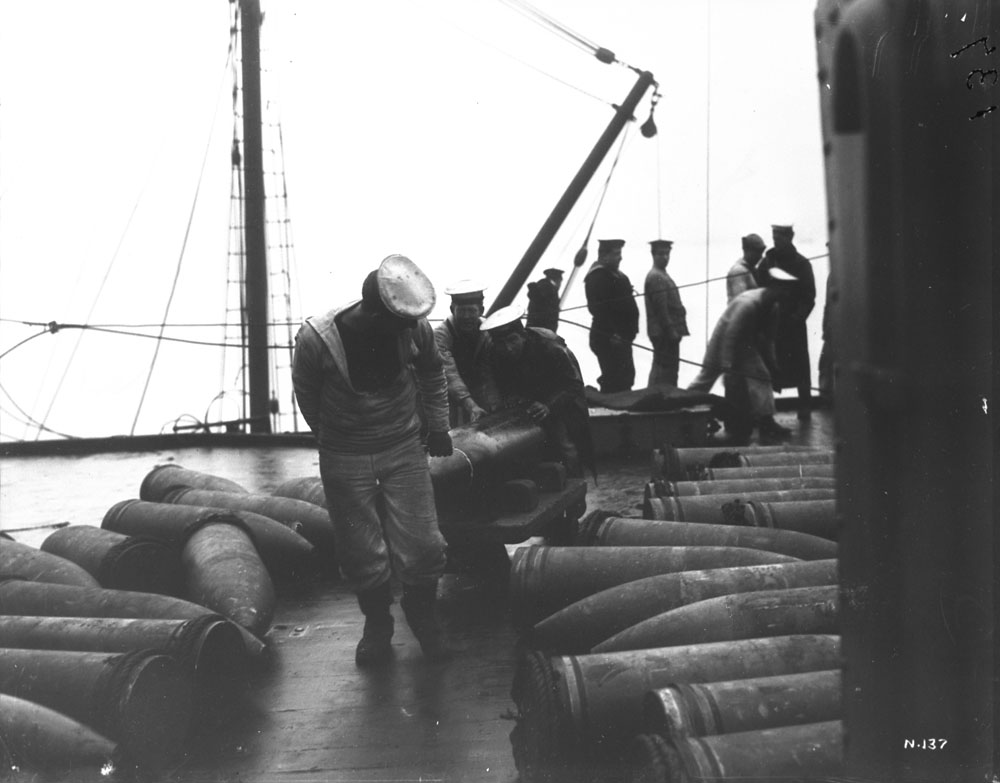
Shells being loaded on HMS Lion, February 1917
But how did Britain, the world's leading maritime power, and an early proponent of most technological advances during this time, end up with ships full of shells that didn't work? The answer is a tangled mix of learning the wrong lessons from war and trials, problems with organizational structure, and the unusual way British procurement took place in the early years of the 20th century.
I've laid out the development of battleship shells in other posts, and so won't go into detail here. Most guns fired two main types of shells, armor-piercing, designed to carry a small bursting charge through thick armor, usually about equal to the shell's diameter, and some variety of common, with a much larger charge and significantly worse armor penetration. The British used a variant known as CPC, capped piercing common, which had an AP cap and the ability to penetrate about 1/2 to 1/3rd its diameter of armor, at least in a normal impact. If the angle between the shell and the plate is lower than 90° (also known as having an obliquity higher than 0°) then penetration falls off.
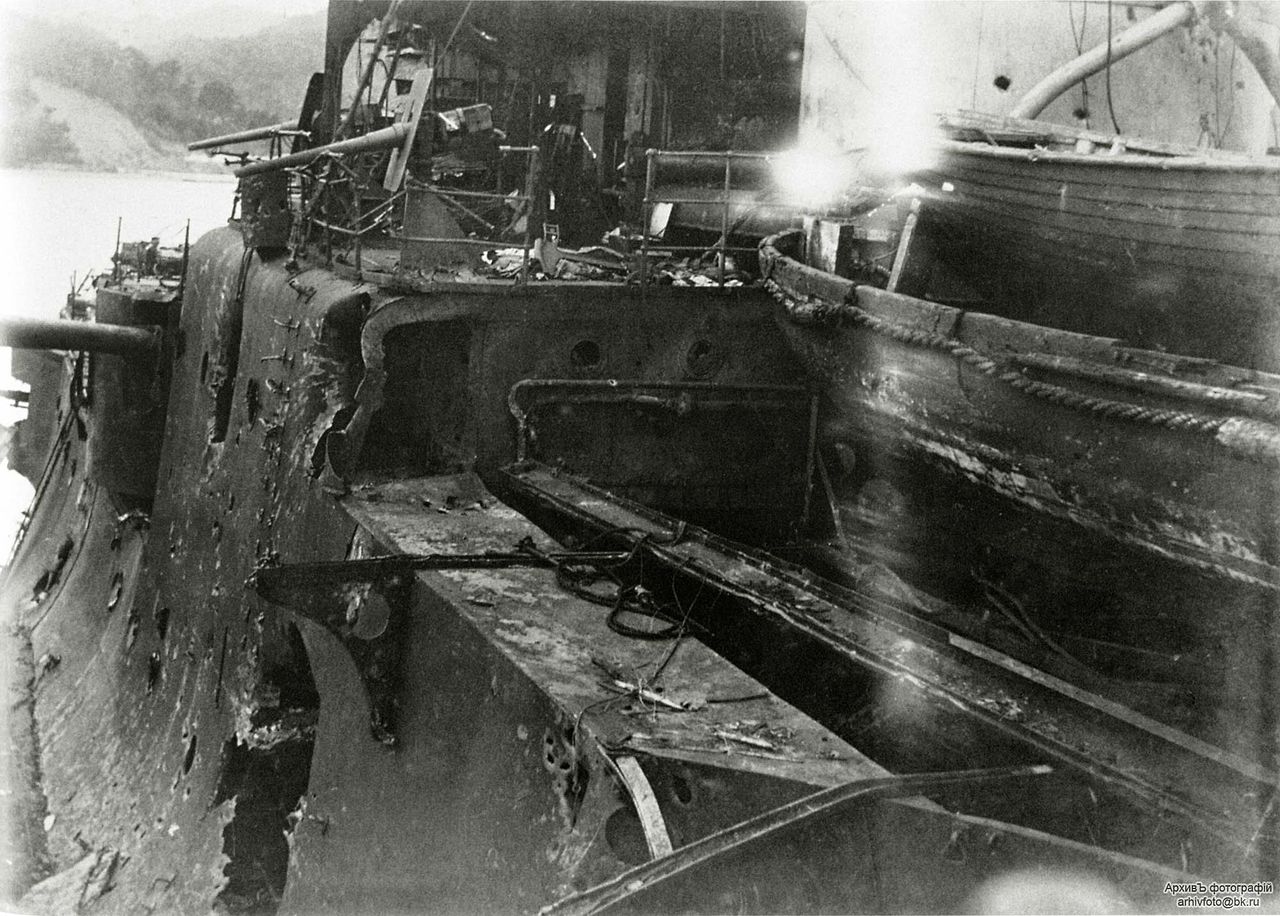
Damage to the Russian battleship Orel after Tsushima
The root of the problem traces to the Russo-Japanese War. The Japanese found that their AP shells were ineffective, and during the climactic Battle of Tsushima, they made extensive use of common shells to destroy and set aflame the lightly-protected upperworks of the Russian fleet. In fact, none of their shells penetrated the main belt of the Russian ships, while the Russian AP shells penetrated reasonably well, but then failed to go off. The British assumed that this was a good pattern for future conflicts, not realizing that the Russian battleships were designed very differently from the vessels they would face a decade later, which were more heavily armored in critical areas and much less vulnerable to fire. As such, their basic plan was to rely heavily on the CPC shell, particularly at long ranges, while saving their AP rounds to finish off the enemy at close range.1 As such, British AP shells were tested only at normal impact. At the same time, improved torpedo performance and developments in fire control pushed up expected battle ranges, with a corresponding increase in impact obliquity.
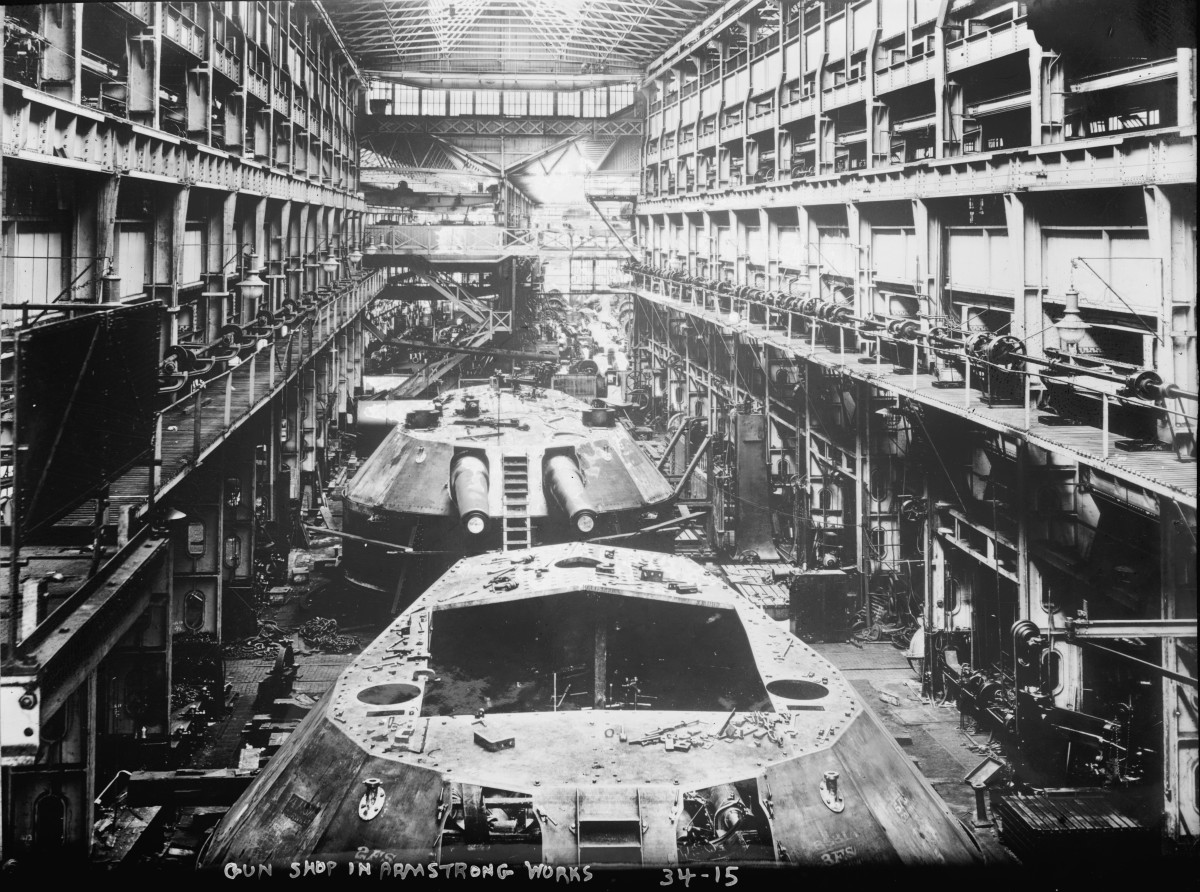
The gun shop at Armstrong's Elswick Works
Into this picture came the tangled world of British ordnance procurement. Since the dawn of gunpowder, the Army and Navy had gotten their artillery from the same source. Until the second half of the 19th century, this made perfect sense, as the guns were often exactly the same. However, with the development of heavy naval guns, their needs began to diverge, and with the demise of the Board of Ordnance in the wake of the Crimean War, all artillery procurement had been moved under the War Office. This left the Navy with little control over its own weapons, and arguably delayed the transition to breech-loading guns. At the same time, the export market for ordnance was growing, and the British duopoly of Armstrong Whitworth and Vickers quickly became world leaders in weapons development. Over time, the Navy managed to get more control over procurement of its ordnance, but this left it short of trained staff and facilities, and it had to rely on Vickers and Armstrong. However, they made most of their money from export sales, and often clashed with the Admiralty over issues such as the confidentiality of shell trials. In peacetime, with large orders of shells not forthcoming, neither company was interested in spending lots of money on shell development, and actively hindered the testing of existing shells. After Jutland, it was discovered that the testing methodology was poor, and shells were often issued to the fleet even though their proof firings had failed. And all of this was despite the shells being tested only at normal impacts. Around 1910, the problem was noted, and John Jellicoe, then Director of Naval Ordnance, called for the production of shells that could penetrate at higher obliquity, but he was soon transferred back to sea duty, and his successors did not follow up, leaving him with inadequate shells when he took the Grand Fleet into battle.
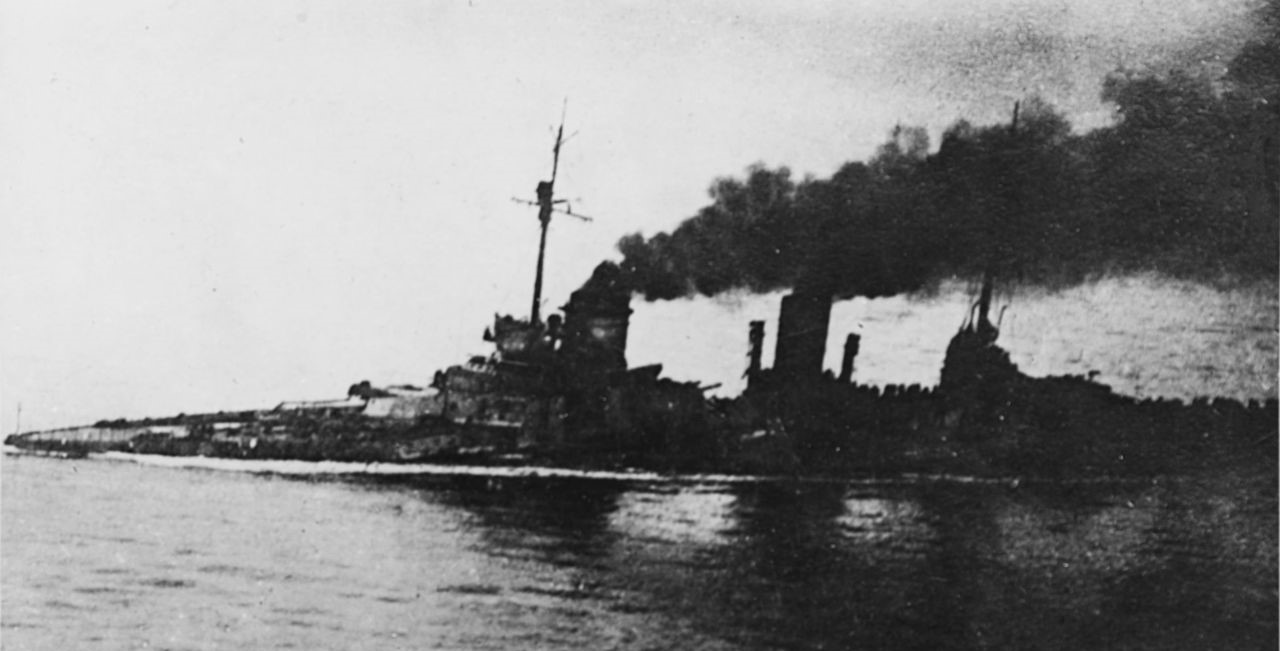
Seydlitz after Jutland
The performance of the shells during that battle was shocking. 17 British shells struck armor of over 9" thickness. One was nose-fuzed high-explosive and three ricocheted off, but of the other 13, only one, a 15" shell that struck Derfflinger's barbette, penetrated successfully and detonated inside the armor. Five others holed the armor they struck, usually because the impact point was on a joint between two plates, but did little or no damage to anything inside the armor.2 The remaining seven didn't even manage that much. This was a pitiful performance, made worse when the results of hits on plates between 6" and 9" thick are considered, as only 3 of the 17 of this type penetrated cleanly. Six more burst while penetrating, and at least some of the effect was inside, but the remaining 10, over half of the total, either failed to hole the plate or did so but burst with no effect inside the armor. With figures like these, it's no particular surprise that Seydlitz, the most heavily damaged of the surviving German ships, took at least 16 heavy shell hits, and possibly as many as 22, of which only 5 pierced her armor.
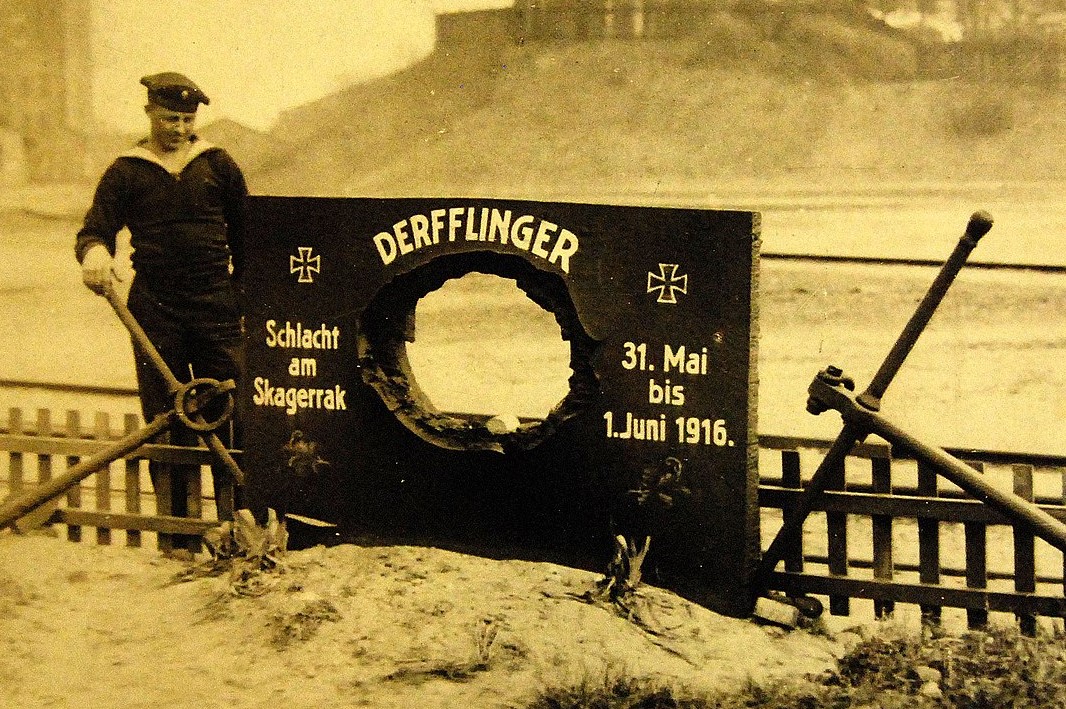
An armor plate from Derfflinger, damaged at Jutland
After the battle, recriminations immediately began over the two great questions raised by the action: the destruction of the battlecruisers and the lack of damage to the Germans. In both cases, this saw the men who had operated the ships facing down the shore establishment that had provided their equipment, with the obvious incentive to blame the other side. Beatty and Jellicoe agreed that the battlecruisers had been lost because their armor was too thin and shells had reached their magazines, while the lack of effect on the enemy was because of inadequate shells. The Admiralty position was that the battlecrusiers had gone up because their crews had disregarded basic magazine safety practices, and that the fleet had simply not gotten enough hits, particularly given the poor gunnery of the battlecruisers during the opening stages of the battle. They also pointed out that the German shells had failed to penetrate any armor thicker than 6", a performance similar to that which rumors from Germany, relayed through a Swedish naval officer, suggested their own shells had turned in. The seagoing officers countered that the largest German shells had been only 12", and that the bigger British shells, many of which were 13.5" and 15", should have done better. Rather ironically, history has generally sided with Jellicoe and Beatty on shells, but against them on the loss of the battlecruisers.
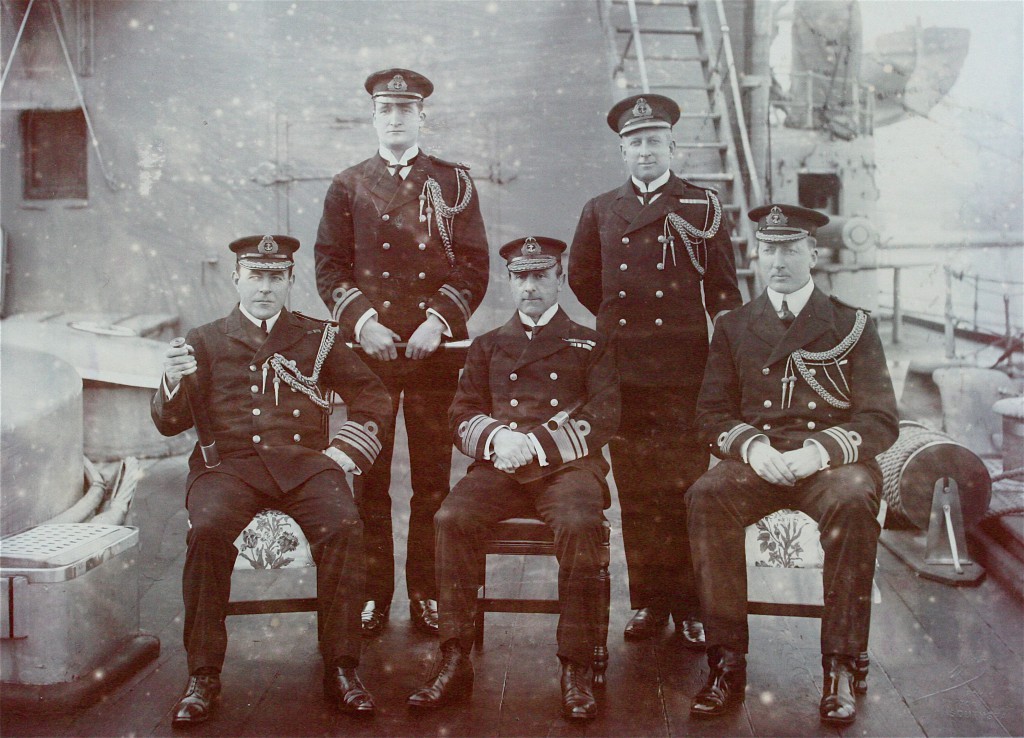
Jellicoe (center) and Dreyer (right)
In the immediate aftermath of the battle, a Projectile Committee was set up, but its work was slow and the final report, issued in March 1917, was fairly bland, despite the discovery that the 15" AP shell would break up on a 6" plate at 20°. However, the rearguard action of the ordnance department had been overtaken by events, as Jellicoe was appointed First Sea Lord in December 1916, a position that allowed him to appoint Fredric Dreyer, formerly his Flag Captain, as Director of Naval Ordnance. Dreyer immediately set about developing an updated shell, capable of penetrating armor at battle ranges and detonating far behind it.
Dreyer set to work, and soon discovered that all aspects of the existing AP shells needed improvement. The caps were too soft and tended to get torn off during oblique impacts, while the shell bodies themselves were not strong enough, and often broke up, which either prevented the filling from going off entirely or greatly reduced its effectiveness. The lyddite filling often detonated on impact, and even if it didn't, the fuze didn't really have an effective delay element, so it went off quickly. Or it didn't go off at all, because the fuzes were also unreliable.

The Grand Fleet late in the war
Despite the other demands of the war effort, Dreyer and his team made astonishingly rapid progress. Orders for trial shells went out in May 1917, and by that September, work was being done to change the shell-filling factory from lyddite to a new material known as shellite, a mix of 60% lyddite and 40% dinitrophenol, a less sensitive although less powerful explosive. The shells themselves were also improved, with heavier, harder caps and strengthened bodies. The new trial standard for a 15" shell was a 10" plate at 20°, and that for 12" shells the 6" plate that had previously defeated the 15", while quality control was tightened. Mass production began in December, although procurement lagged behind schedule because of problems with the suppliers and conflicting wartime priorities. The first of the new shells, known as "greenboys" because of their color, reached the fleet in April 1918, and by the time the Armistice was signed, they had essentially replaced the previous AP shells. If the Germans had come out to fight in the closing days of the war, they would have found the Grand Fleet armed with an AP shell the equal of any in the world.3
1 This can be seen as the long-range big-gun extension of the way pre-dreadnoughts were expected to fight, where QF guns would smash up the enemy's upperworks and then the main guns would fire AP to penetrate the citadel. ⇑
2 This is entirely plausible, particularly when you remember that the bursting charge of an AP shell is concentrated in the back. There are several mentions in Campbell of the the noses of AP shells continuing on after the shell burst, and I suspect that most of these cases saw the front half penetrate and the back half explode outside. ⇑
3 Norman Friedman, as usual, has an interesting perspective on all of this. He suggests that prewar thinking had been that ships could only be sunk by cumulative damage (and thus the loss of the battlecruisers was a shock to everyone) but that the German's attempts to break loose at Jutland had denied the British the opportunity to batter them. The Greenboy was primarily intended to penetrate to the machinery spaces and slow the German vessels down enough that they could be battered to death. ⇑

Comments
So to clarify: the British decided before Jutland that using CPC shells against the German ships would be a bad idea, and the discussion of shell performance here refers to the AP shells?
How do they test the shells?
Given the practicalities and accuracy involved, it seems like aiming at a 10' test plate at 10k yards would be hard, so they probably make up a test plate with the appropriate obliquity at 100 yards and adjust the powder load to give the correct velocity, but I just wanted to check on that.
@ADA
No. They fired a mix of CPC and APC at Jutland. The breakdown I have says 1,750 APC, 818 CPC, 567 HE and 1,045 unknown from the heavy guns. The HE were all from 12″, while the unknown were either APC or CPC from 13.5″ and 15″ guns. In practical terms, the two were similar enough that it doesn’t matter a huge deal.
@redRover
That's correct.
Great site and great info Bean, love your articles. Proof that the internet isn't a vast wasteland of kitten vids and selfies.
Keep up the good work!